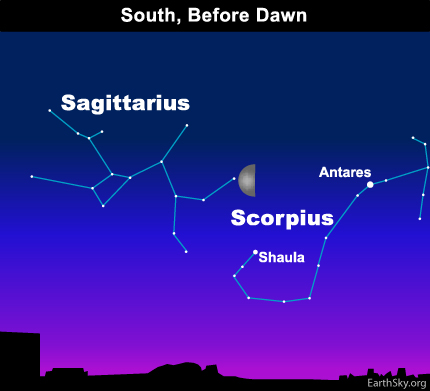Courtesy of EarthSky
A Clear Voice for Science
www.EarthSky.org
 On the morning of March 8 (Monday), the rather wide waning crescent moon helps you to locate the two stars in the tail of the constellation Scorpius the Scorpion. These two very noticeable stars – called Shaula and Lesath – are often shown on old star maps at the tip of the Scorpion’s Stinger.
On the morning of March 8 (Monday), the rather wide waning crescent moon helps you to locate the two stars in the tail of the constellation Scorpius the Scorpion. These two very noticeable stars – called Shaula and Lesath – are often shown on old star maps at the tip of the Scorpion’s Stinger.
These star names mean raised tail and stinger respectively in Arabic, although there is some controversy over the origin of Lesath. It may originally have been a Greek word for foggy. Why are so many star names from the ancient Arabic? Observations by Arabic astronomers when European astronomy was in the Dark Ages, resulted in the fact that many of today’s star names are now in Arabic.
The Scorpion is a very noticeable constellation, one of the few that looks like its namesake. To northern hemisphere viewers, this pattern of stars appears to have a curved tail sweeping down toward the southern horizon. Antares is the brightest star in Scorpius, but Shaula and Lesath are very noticeable, too, for being at the end of the curved tail pattern and for being so close together on our sky’s dome. You will spot them easily if you look outside – under the moon – Wednesday morning.
Stories about Shaula and Lesath about vary greatly, but in some Polynesian legends these two stars were called Pipiri and Rehua, a brother-sister pair who, angry at their parents for some imagined unfairness, ran away to the sky where they are now stuck as stars. In reality, they are indeed slightly related to each other (and many others) in that they are young as stars go and are of similar star types (B). They also may have been formed from the same interstellar cloud. They are not that close together, however, as Shaula is 700 light years away, and Lesach about 520.
Written by Larry Sessions
Other Links:
The York County Astronomical Society